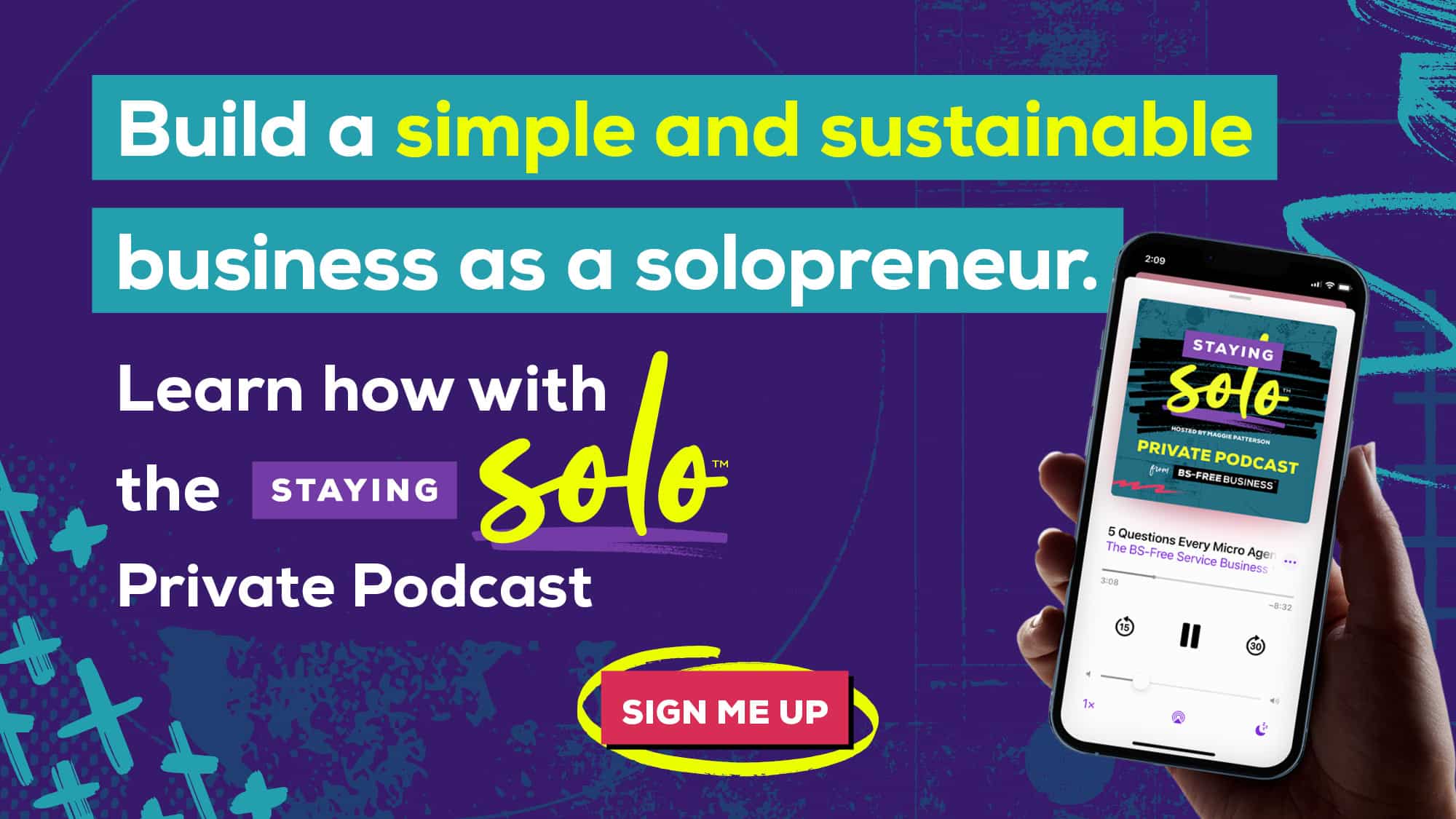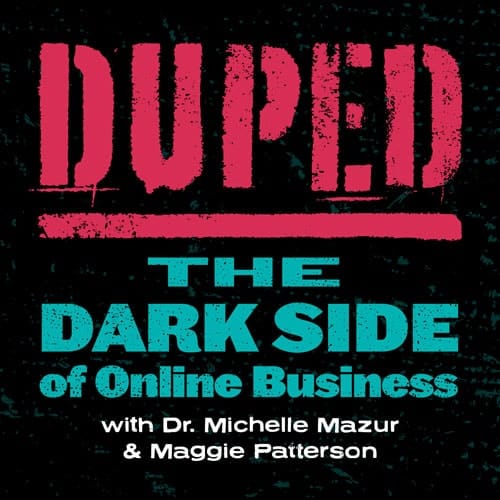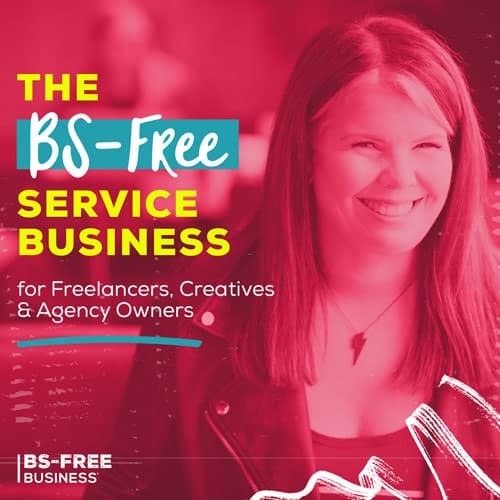The 2023 Online Business Investment Survey

By Maggie Patterson
All opinions in this post are my opinions and mine alone.
Listen Now To This Essay On The BS-Free Service Business Show
In April 2020, something in me completely broke when watching how the online business world was responding to the pandemic.
After watching celebrity entrepreneur (or should I just say grifter?) after celebrity entrepreneur use it as an opportunity to ramp up their sales activity to cash in on the uncertainty, discomfort, and financial stimulus funds provided to business owners, I was disgusted.
At that point in, I was seven years into my online business journey, so I was no stranger to their scammy marketing and sales practices. I’d been talking about it for years on my podcast and, well, with anyone who would listen to me.
But this was some next-level BS, and I decided to get louder. I renamed my podcast and doubled down on my social media with a clear mission of helping people cut through the BS.
As 2020 carried on, I became increasingly curious about how people were spending their money, and the Online Business Investment Survey was born.
In early 2021, I released the first edition of this survey to understand why people made the investments they did and what their experiences were really like. In a market with very little open discussion of people’s experiences, this survey helped shed light on how people were manipulated and what they wanted from their investments.
Fast forward to 2023, and I’m still here banging my drum about the BS in the online business world, so I decided to do the survey again to explore how things have evolved over the past two years.
OVERVIEW
The scammy status quo of sales in the online market means that the odds are stacked in the seller's favor, and far too many times, buyers get screwed over.
In designing my survey, I wanted to get insight into people's experiences in this industry in their own words while compiling hard data. In December 2022 and January 2023, I surveyed 60 people who provided in-depth answers on their best, worst, and most expensive investments.
Before we go any further, I want to thank everyone who participated and shared their experiences. Their willingness to be vulnerable and share their experiences made this essay possible.
Here’s what I uncovered in the 2023 survey.
About the Survey Participants
All participants are business owners offering a wide range of services. Their experience level varied, from people just starting their business to people who’ve been at it for more than 20 years.
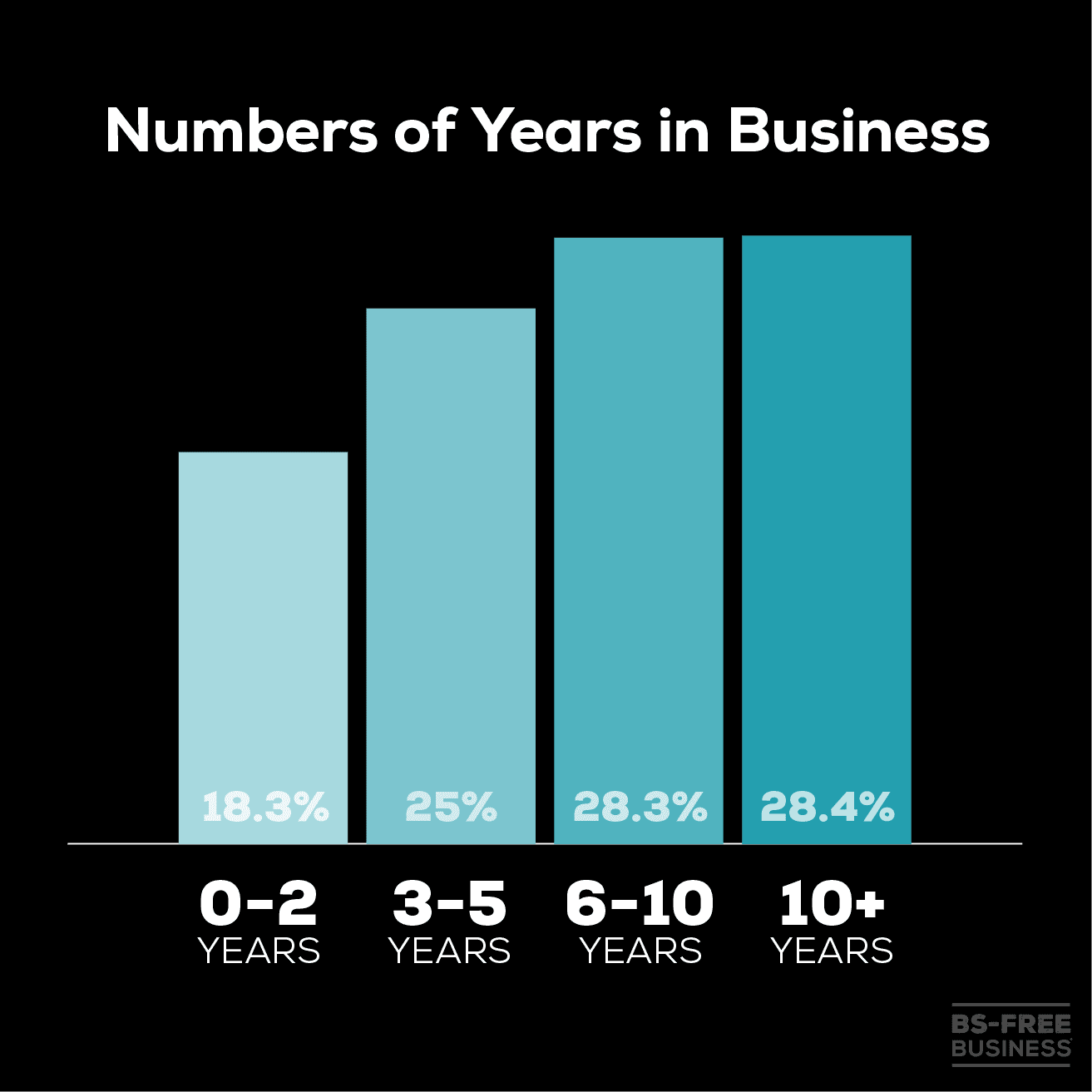

For this survey, the investments included were courses, masterminds, coaching, and group programs. When asked how many investments they’ve made in the last three years, 48.3% had invested in 1 to 5, 38.3% in 5 to 10, and 13.4% in 10 or more.

THE BEST & WORST BUSINESS INVESTMENTS
We often hear horror stories about failed investments made in this industry, but I wanted to provide a balanced look by looking at the best and worst investments people made.
What Type of Offer Was It?
The results are evenly matched when you look at the best vs. worst business investments in terms of what those offers were. Each type of offer has a significant number of people who had both positive and negative experiences.
This is valuable insight as there’s a tendency in this industry to position one type of offer as superior to another when it comes down to the offer itself and if it delivers as promised.


How Much Did You Spend?
Next, I wanted to compare and contrast the best and worst investments to see if the cost affected how people rated their experiences.
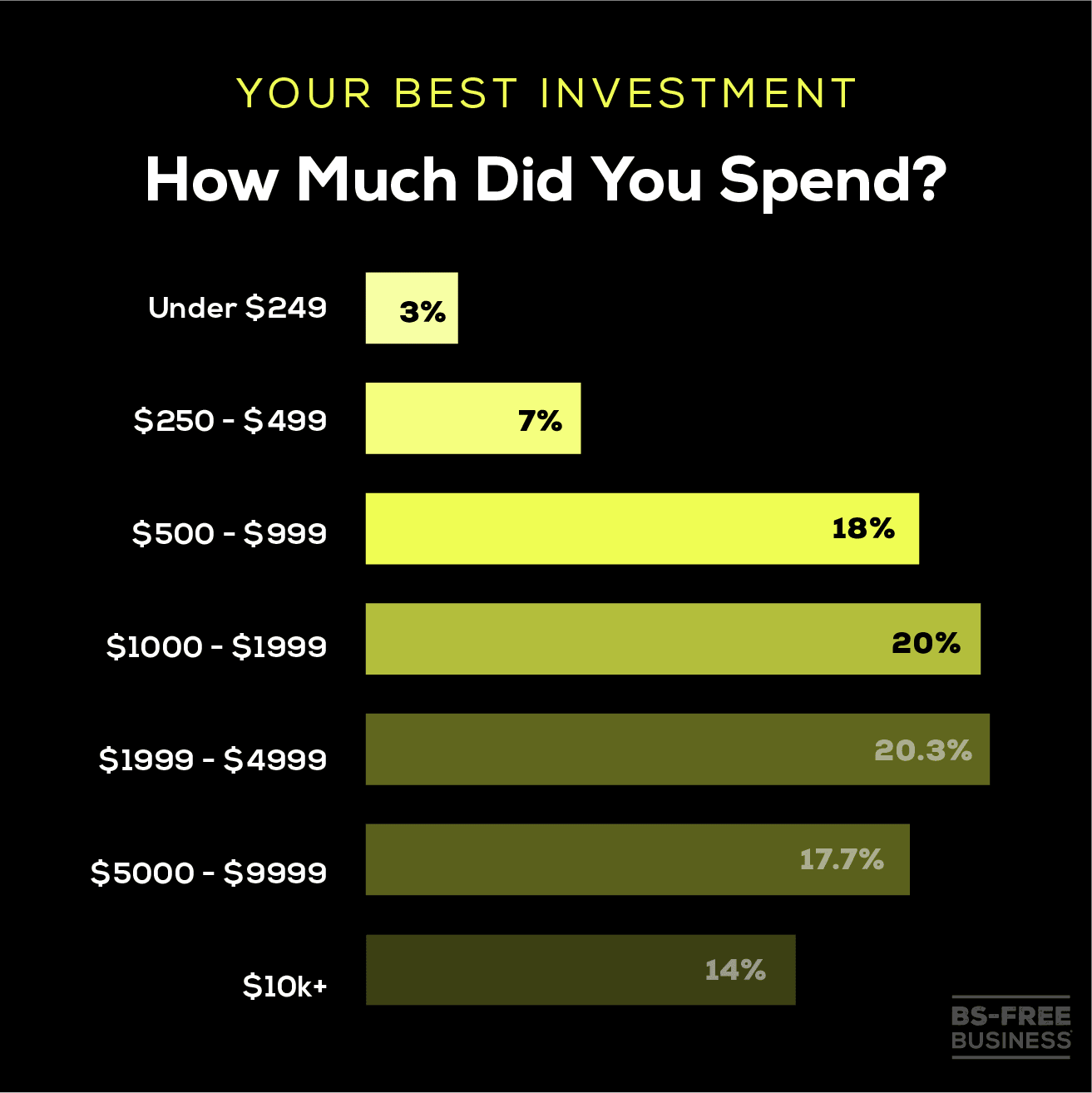
For the best investments:
- 3% spent under $249.
- 7% spent between $250 and $499.
- 18% spent between $500 and $999.
- 20% between $1000 and $1999.
- 20.3% between $2000 and $4999.
- 17.7% between $5000 and $9999.
- 14% over the $10k mark.
For the worst business investments, 6.7% spent under $249, 11.7% spent between $250 and $499, 8.3% spent between $500 and $999, 16.7% between $1000 and $1999, 23.3% between $2000 and $4999, 15% between $5000 and $9999, and 18.3% over the $10k mark.
For the worst investments, 73.3% of them are over the $1k mark. Interestingly in looking at the results from the 2021 survey, the worst business investments at this threshold were 63% of the total.
While I can’t prove this, I believe we can attribute the over 10% to the ever-increasing pricing window in this market. In the past two years, the high ticket hustle has been inescapable, resulting in these investments costing more, even if the quality or value doesn’t increase.
When you compare the best vs. worst investments, they’re pretty evenly split in terms of the dollar amount of the investment made.
This is of particular note as a standard message in this industry is that if you pay more for something, you’ll get better results. With the results for best and worst investment at the above $5k level being nearly the same, it shows that price isn’t automatically why people rank something as the worst investment.
When asked what made the best investment a success for them, answers generally fell into three different categories:
- Networking/Community.
- Quality of Content/Programming.
- Level of Support Provided.
This is a mirror image of the 2021 results, especially when you consider what people aren’t saying is why they ranked something as the “best” business investment. Survey respondents rarely mentioned making more money as the driving force for something being their best investment, which is fascinating considering that it is the #1 marketing message in this market.
When asked about how the best investment impacted their business, here’s what they had to say:
“I got my message, marketing plan, systems, and mindset straight. The coaches helped me implement this by providing accountability and feedback.”
- Dina Wittfoth, Brand Strategist and Identity Designer, BigHeartVenture Coaching
“It helped me double my income and change my positioning to one that aligned with me and my lifestyle.”
- Charlotte Goss, Charlotte Goss Virtual
“It helped me to understand the structures I needed to implement for business success so that the service delivery aspect of my business stays high-quality as I grow.”
- Allison Grant Lounes, Your Franceformation
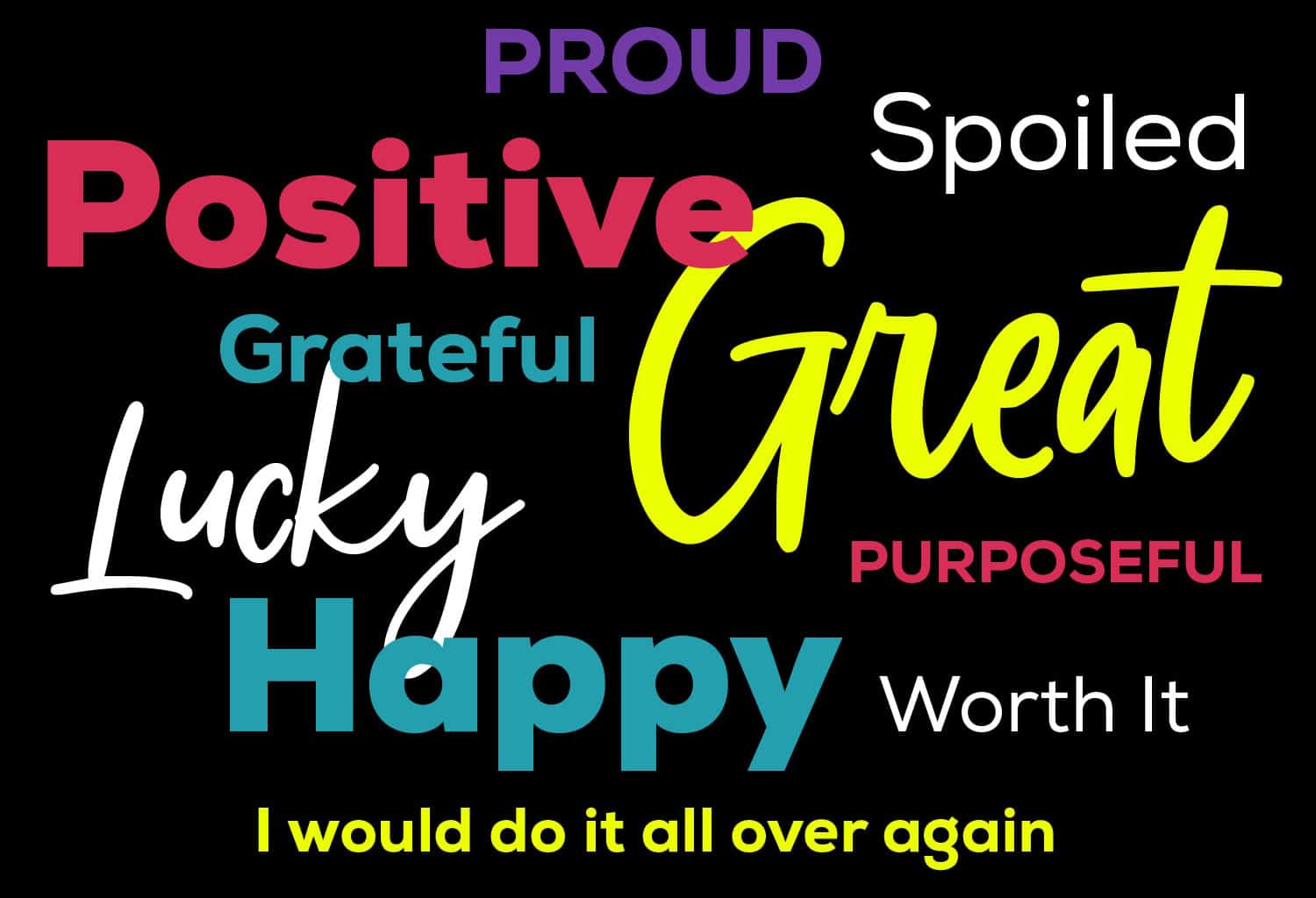
For the worst investments, the reasons varied wildly, with people citing lack of support, poor quality programming, and it being a bad fit many, many times over.
“I was not seen or heard. Many assumptions were made about me based on what the coach thought they knew about my work, with little to no interest in listening to me. As for the business impact, I spent a lot of time doing the wrong things. I spent a lot of money, which impacted my business negatively.”
- Chioma Njoku, The Mindful Bookkeeper
“The group was too big (though it was advertised as “intimate” which is very relative), so hot seats weren’t available for everyone unless you’re willing to spend two plus hrs on the call.”
- Mai-kee Tsang, Mai-kee Tsang Media
The frustration with worst investments was high as people shared how they didn’t learn anything, got zero ROI on their investment and felt like a number.
“I spent $10k to learn high-pressure sales techniques. I didn't know that's what the program taught.”
- Jennifer Anastasi, Jennifer Anastasi LLC
“I got caught up in some of the money-led marketing hype. The coach also did things more ethically than others, so I focused on the things I liked that stood out from other coaches. It messed with my definition of success and had me questioning my offers and my business model. I felt under-supported and anxious about the amount I spent.”
- Kelli Jones, Kelli Jones Law, PLLC
“My coach promised consistent $10k to $20k months, and when I didn’t have those results, the coaching for me was to stop making it so complicated.”
- Stephanie, Booth, Safe Haven Coach
“It was over-priced for minimal, low-quality content. The content description was vague to non-existent and the promises were big. I bought it because I trusted one of the people co-delivering it.”
- Bex Morley, Bex Morley Design
Selling the Dream…Which Becomes a Nightmare
With the worst investments, I also asked why people felt motivated to make that investment. The responses highlight how people are being played in this industry using various manipulative tactics
The most common answer was that people bought into the dream but then found themselves inside these offers and discovered that things were not as promised.
Many of these offers sold a dream of financial success that failed to materialize. They promised $10k, $20k or more months based on what they were teaching, and very few people actually were able to achieve those outcomes. A common theme was that people were pissed off that their money and time had been wasted and that when they looked at their peers in the program, they didn’t see them getting the promised results either.
This type of marketing weaponizes our hopes and desires against us while tapping into any desperation we may feel about our finances or personal situation. The way the dream is being oversold in this industry is predatory, as it usually fails to deliver.
“I hoped to be a millionaire in my PJs that could work from anywhere. I was hoping I could save for retirement. I was hoping I could be home for my kids. As a photographer, the idea of tossing my camera aside for a better lifestyle never entered my mind before I saw former photographers touting their celebrity lifestyle and the millions of dollars that they made teaching courses online.”
- Kelly Lawson KLP Media Inc.
“It was going to teach me to "scale" my business. I was still new in my business and naive, but you know, many well-respected people were testimonials for this program—people I trusted. I thought this was what I was "supposed" to do to grow my business. I'm so glad I'm older and wiser now.”
- Alexis Burhman, Alexis Buhrman Coaching + Consulting
It’s frustrating to hear these stories and know they were nothing but a number to the people they paid.
Humanizing these stories is a big part of the reason I do this work, as I want to remove the shame people feel after being duped.
Here are just a few of the answers about how people feel when they think about this investment:
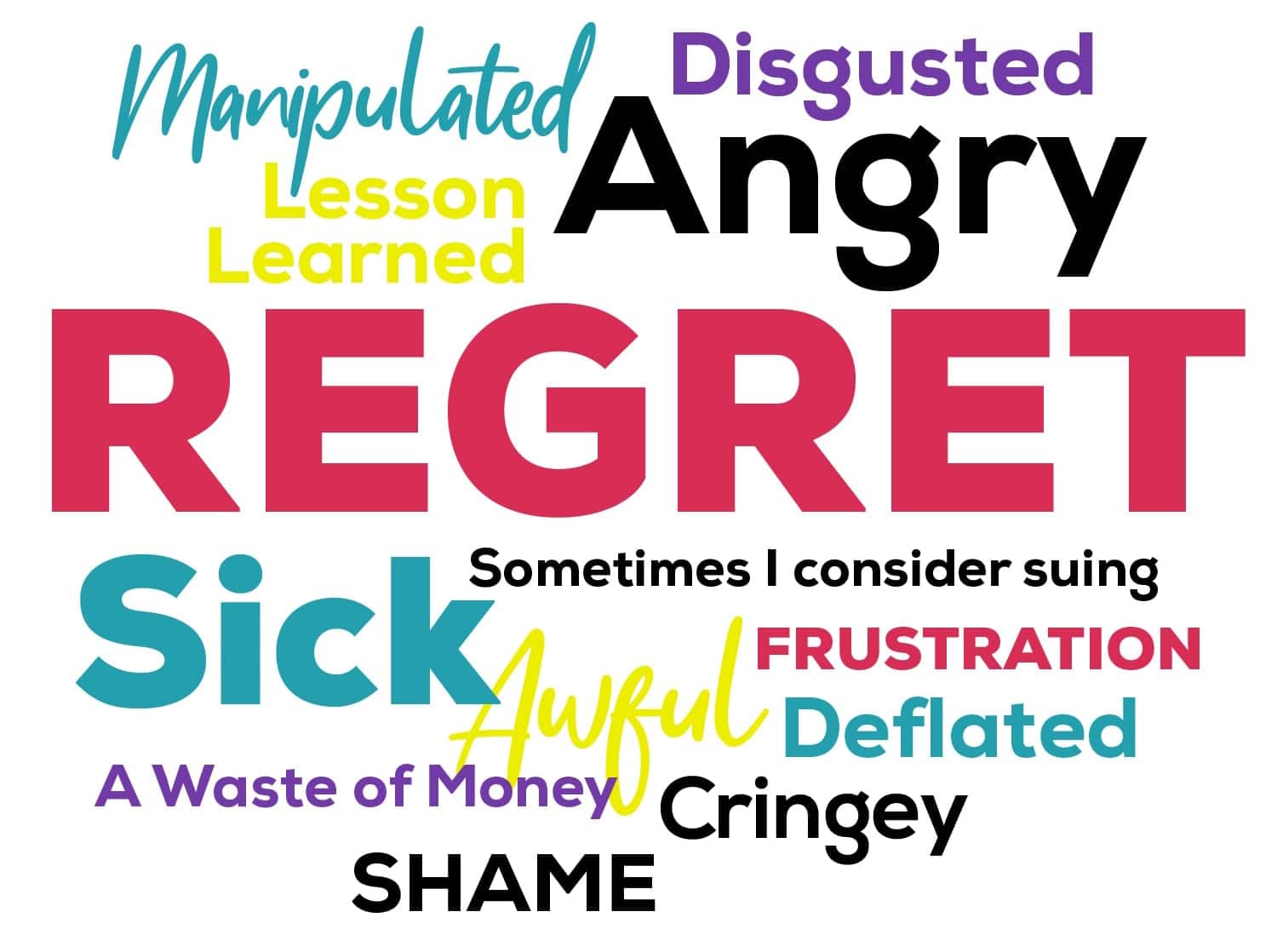
The question I have to ask is, what are we doing as an industry that makes it okay for businesses to treat their customers this way?
If you’re feeling rage after reading this section, let that be the fuel you need to demand more from the people you do business with, as the status quo is scammy, and it’s harming all of us. We have choices regarding how we spend our money as consumers, and we need to vote with our dollars by not doing business with people who make BS promises and then screw us over.

MOST EXPENSIVE BUSINESS INVESTMENT
The survey also explored the most expensive business investments people had made in the last three years. I was motivated to ask this question based on curiosity about pricing in the market, as well as digging into the pervasive myth in this industry that if you pay more for something, you’ll get better results.
What Type of Offer Was It?
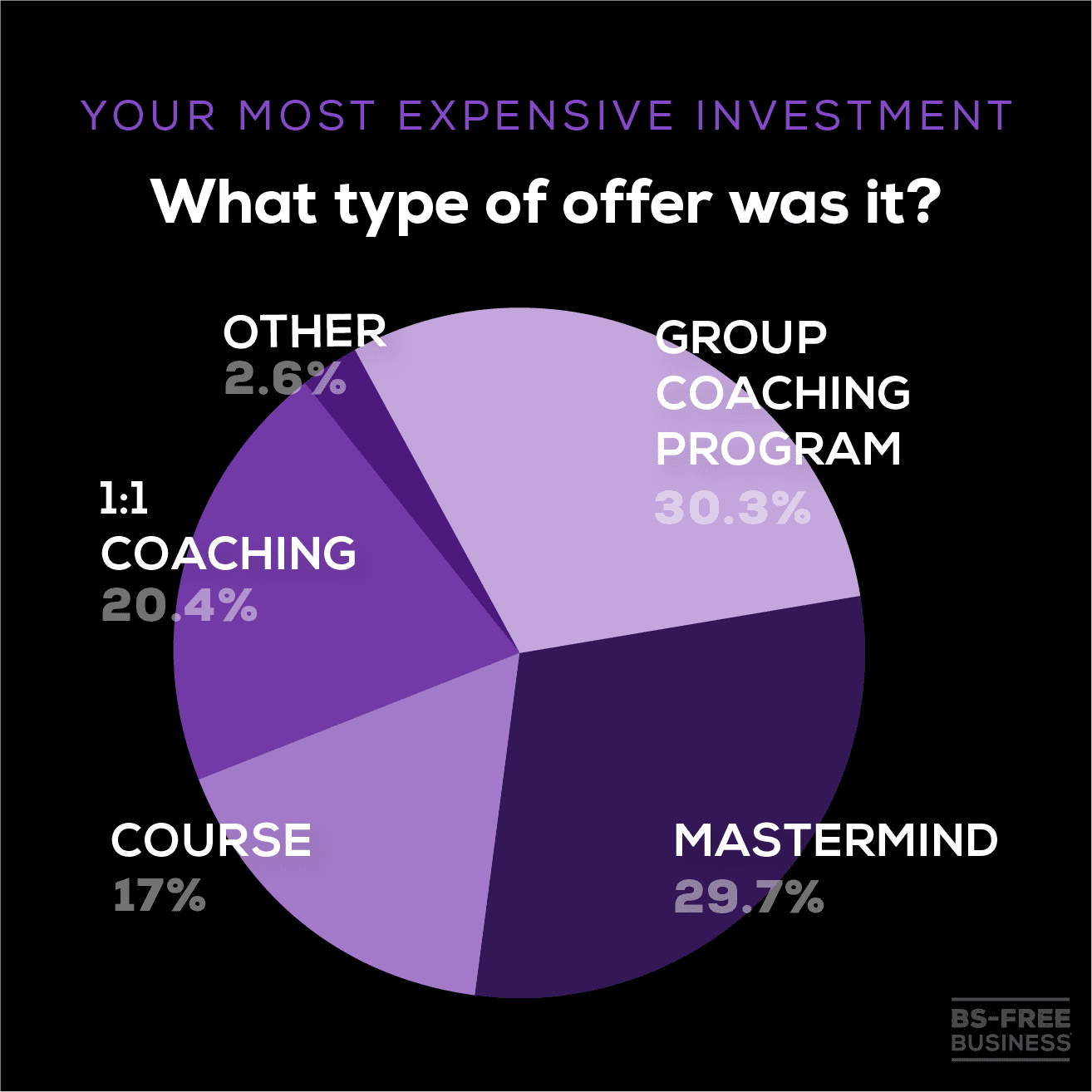
The most expensive investments broke down as follows. 30.3% were group coaching programs, 29.7% were masterminds, 17% were courses, 20.4% were one-on-one coaching and 2.6% were other.
Over half of these investments, at 58.3%, were spur-of-the-moment decisions, while 41.7% were planned for. This split was encouraging to me as so much of the marketing and sales tactics used in this industry are designed to drive spur-of-the-moment decisions.
That said, this result is a shift from the 2021 survey, where 61% of investments were planned, and it likely reflects the fact that in the current climate, people are feeling uncertain and more vulnerable to this type of pushy marketing.
When asked how much people spent on their most expensive investment, 1.7% was under $249, 1.7% in the $500 to $999 range, 13.2% spent between $1000 to $1999, 26.7% $2000 to $4999, 21.7% $5000 to $9999, and 35% at $10,000 or more.
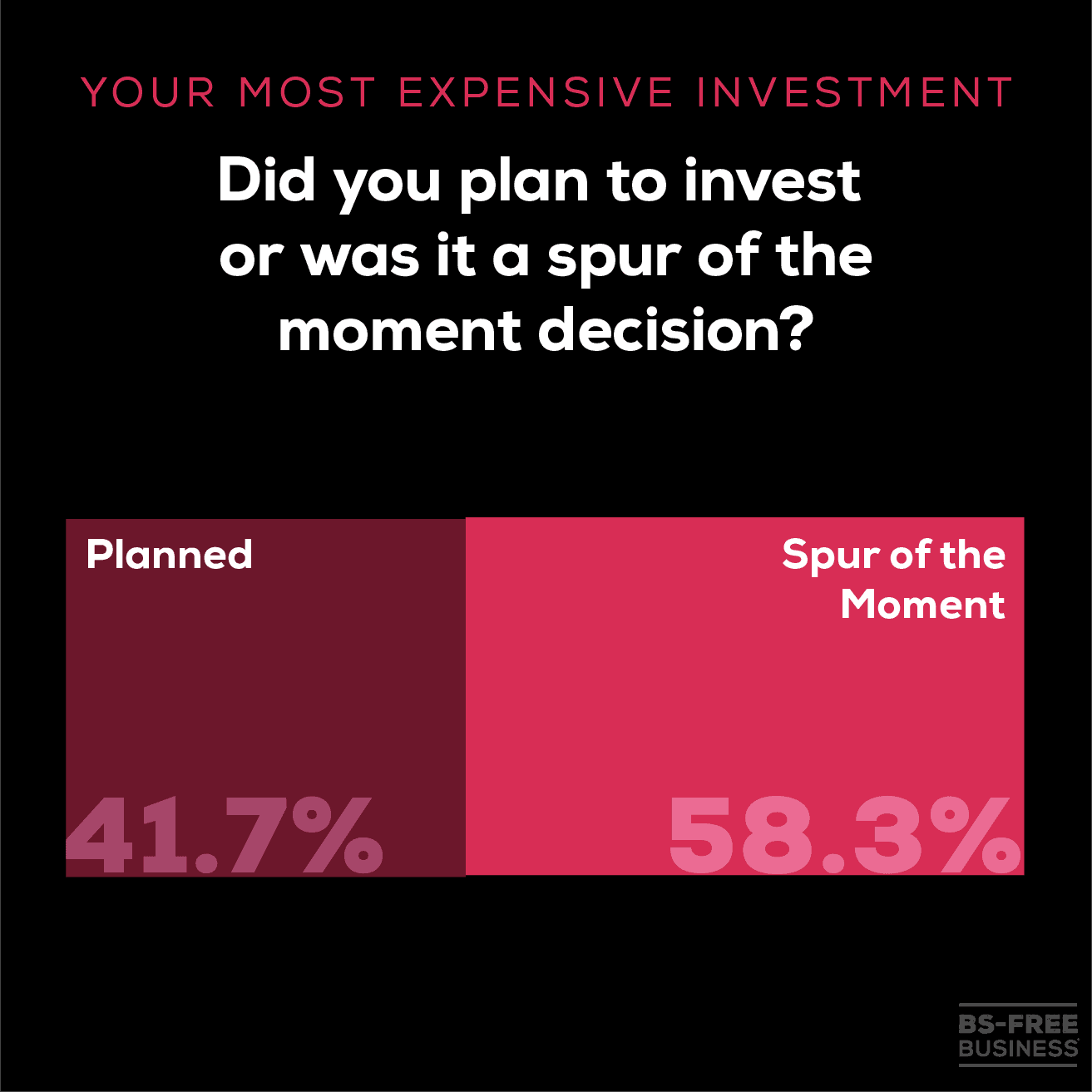
How Much Did You Spend?
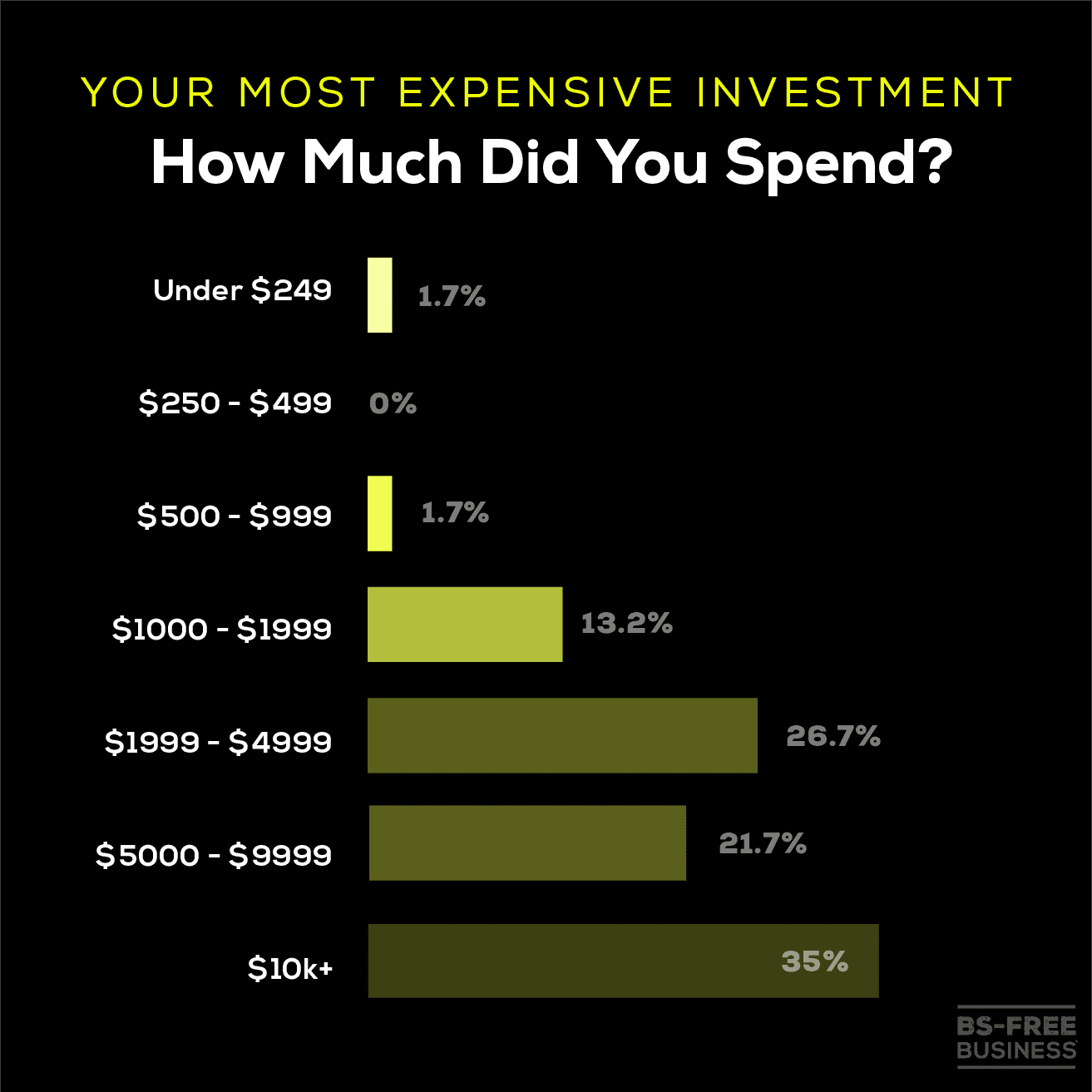
Here’s where things get interesting: 83.4% of these investments were over the $5k mark. This stands out to me as Fundera reports that small businesses in the US with no employees have an average annual revenue of $46,978, and 86.3% of small business owners make less than $100,000 per year.
Looking at those numbers, if you’re making an average of $46,978, $5k is 10.6% of your revenue, and a $10k investment is 21.3%. That is a significant portion of revenue, which is being “invested” in growing the business but often becomes a liability for the time, money, and energy spent.
How Satisfied Were You With Your Experience?
With satisfaction and the most expensive investments, there was an even distribution, with 15% rating it a five or most satisfied, 20%, a four, 30% a three, 13.3% a two, and 21.7% a one.
For those that indicated they were satisfied, they shared the following:
- Support and availability of the coach
- Solid and helpful information
- Delivered as promised
- Great community and support
- Valuable/actionable content
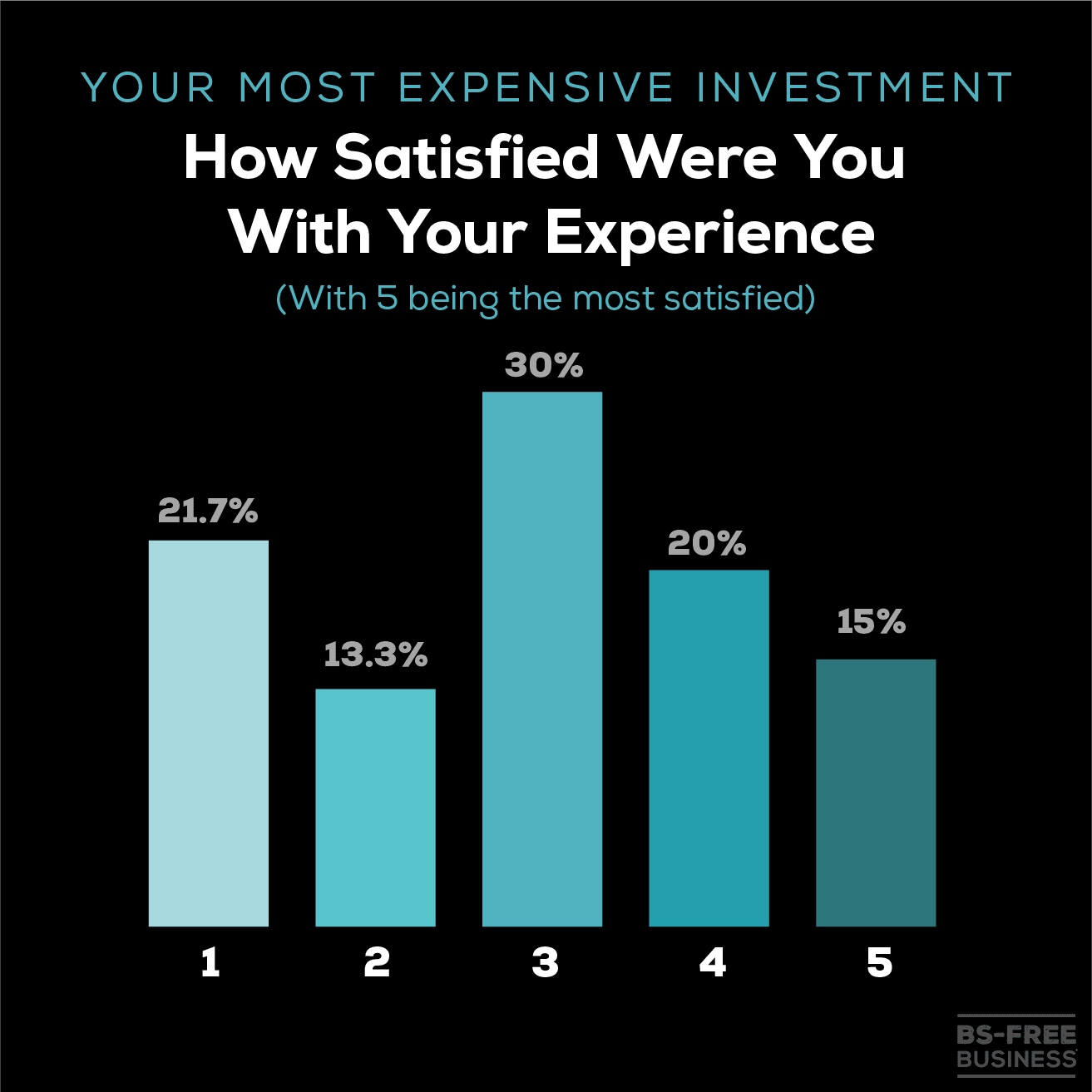
“This person is an ethical, transparent creator. I had been in their orbit for a while and had done a couple of mini-courses from them, so I was fairly certain by that stage that I could count on the helpfulness of the content and trustworthiness of the person.”
- Ellen Ronalds Keene, Perk Digital
“This was exactly the right thing at exactly the right time. I was very intentional about picking the type of coach, the container (1:1), the duration, and the price point of this. I felt stretched but not dysregulated. My coach also held me through one of the most difficult times of my career, which resulted in a long legal battle. I’d do it again in a heartbeat.”
- Dina Wittfoth, BigHeartVenture Coaching
For those that were unsatisfied, let me tell you reading these was a real journey and very much mirrored comments about people’s worst investments.
Here are the most common reasons for being unsatisfied:
- Lack of impact on my business.
- Too expensive for the value.
- Lack of support.
- The group was too big.
- Zero access to program creator/coach.
- Info was super basic or there was too much information.
- It required an extreme amount of work.
Beyond issues with the design, delivery, and community, there were also issues with how the programs were sold, the behavior of the coaches, the fact the person was not an expert, and false promises.
“She was always 20 minutes late to calls. She also provided the same coaching to me that she did to her free group. She was also trying to upsell me to her mastermind. When I spoke to this, she blamed me and told me I did not tell her how I wanted to be coached.”
- Chioma Njoku, The Mindful Bookkeeper
“The group was way too large and the material was geared towards beginners, even though the program was pitched as suitable for up to $1M in revenue.”
- Jessica Lackey, Jessica Lackey Consulting

YOUR BUSINESS SPENDING HABITS
Finally, I asked about how people were spending in their business, starting with asking if they budgeted in advance for these purchases.

46.7% of people surveyed responded no, while 53.3% indicated yes. Apparently, I have some work to do in terms of continuing to encourage people to budget in advance for their business investments. I firmly believe having a defined budget for coaching and programs acts as a line of defense against making investments that go wrong. It forces you to slow down and consider the investment instead of being swept up by the hype and big promises.
Interestingly, I asked people what they consider when making a purchase, and an overwhelming majority talked about money-specific considerations. These included if they had the budget or could afford it, the cost vs. expected results, and short and long-term ROI from the investment.
Beyond the financial aspects, people assessed investments based on the following:
- Feedback/input from people who’ve taken it.
- Time and capacity required.
- If they’re a real expert.
- Alignment with goals.
- Size of the community.
- Access to the leader.
Finally, many people shared that they’re getting wise to the sales tactics used to get them to buy, and when they see certain things, they treat it as a red flag and opt not to purchase. This included tactics such as long application forms, markups on payment plans, and artificial urgency tactics.
Much of the messaging in this industry encourages people to get outside their comfort zone and level up by investing more than they can afford. 78.3% of people answered yes, they’d made an investment they could not comfortably afford, while 21.7% said no.
This illustrates not just how pervasive the invest at all costs message is but just how effective it is. Interestingly, the number of people indicating they’d made an uncomfortable investment is slightly up from 71% in 2021. This may be an indication of both the intensification of this message, as well as how people have been investing amid a time of uncertainty where many people are constantly uncomfortable for a variety of reasons.
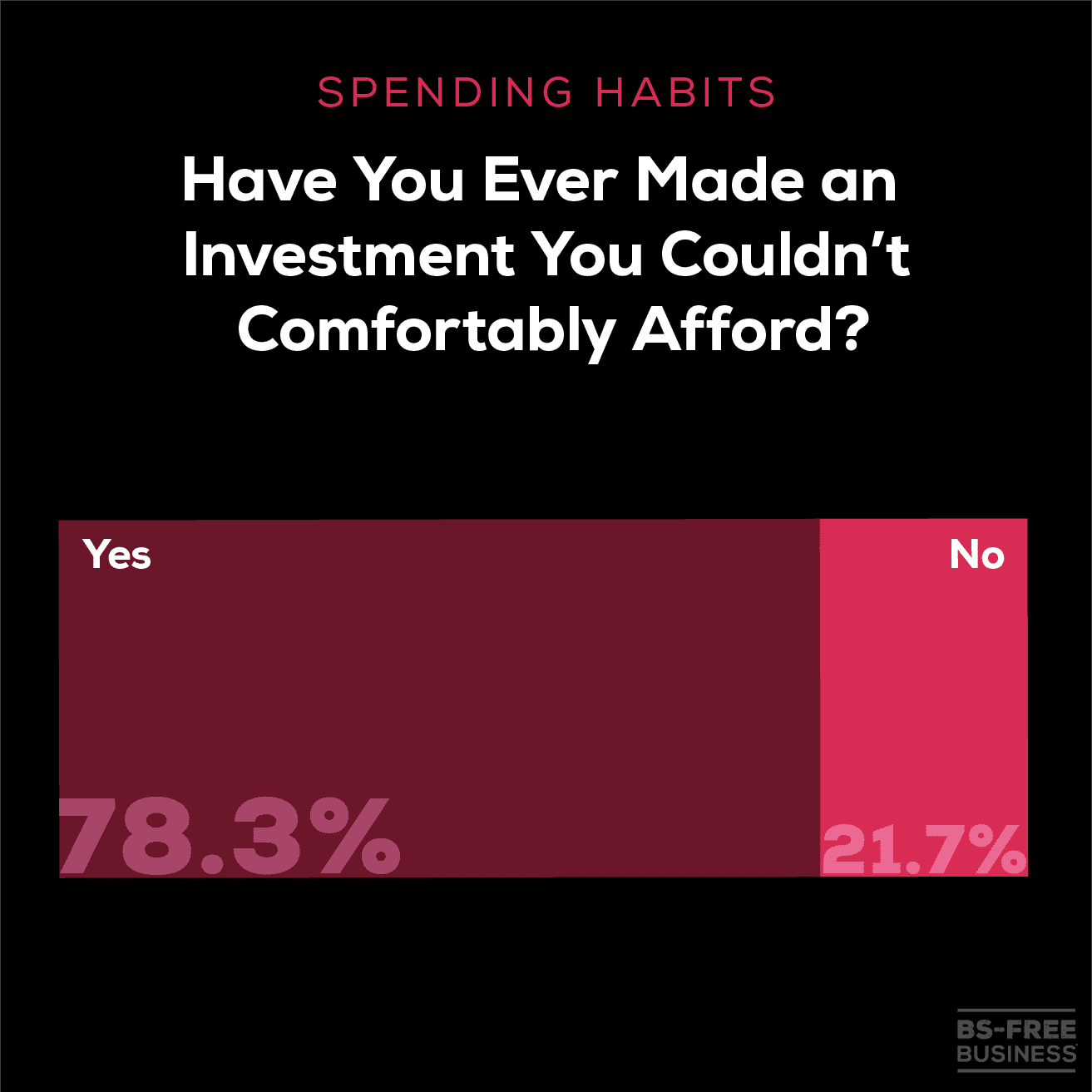
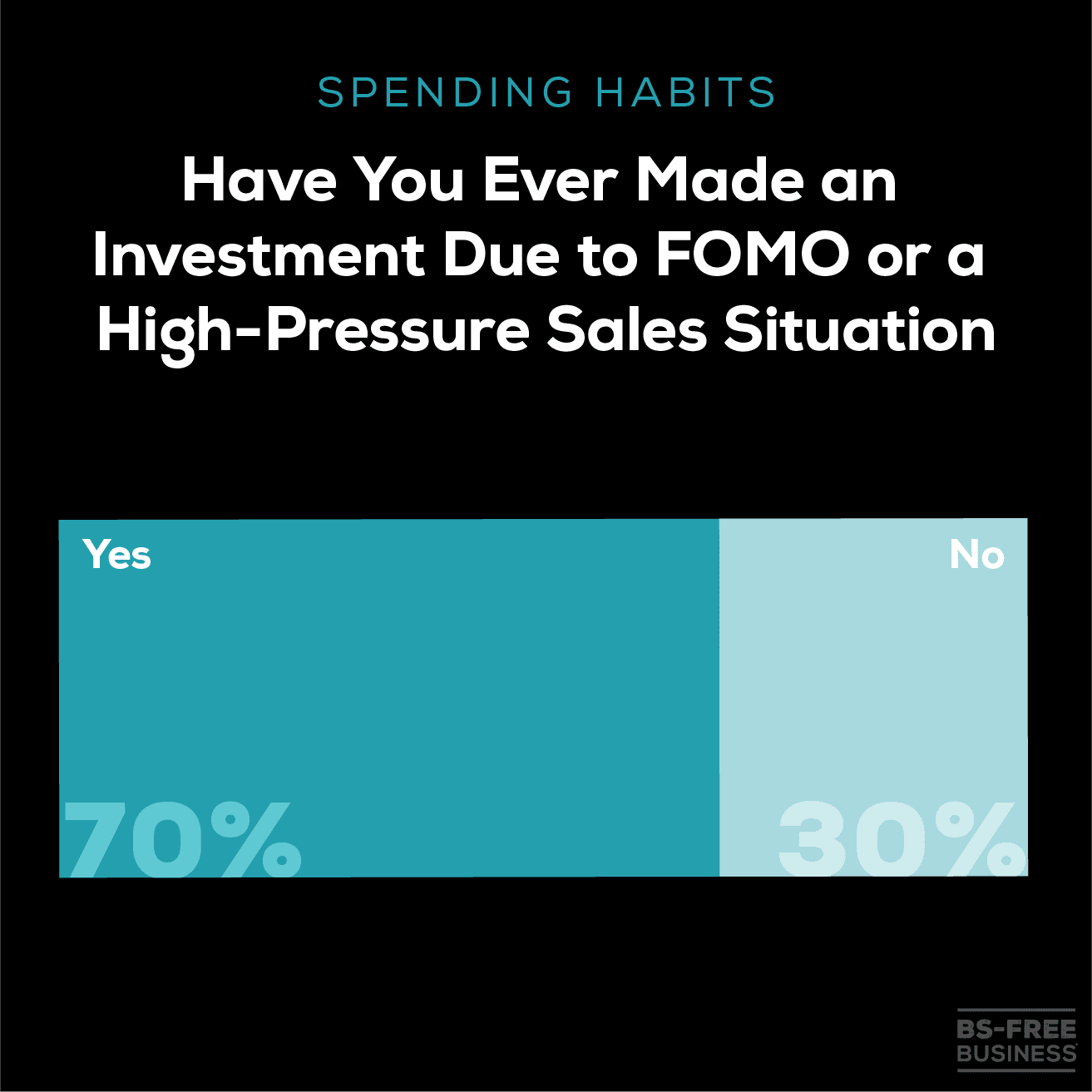
When you combine that uncertainty (especially financially) with the tactics commonly used to market and sell in this industry, it’s a recipe for high-pressure situations and FOMO.
70% of people had purchased due to FOMO or a high-pressure sales situation, up by 2% from the 2021 survey.
To help understand what was happening to people then, I asked them how they felt and why they made the purchase.
“Scared. The price was going up, OR there was one spot left.”
- Stephanie, Booth, Safe Haven Coach
“Desperation and the feeling that I had to "do something" to turn things around financially and that making the "investment" would inspire the universe to follow that up with the money.”
- Allison Grant Lounes, Your Franceformation
“Total FOMO. Big promises and time was running out. The implication was that I would be cheating myself of an amazing business-changing opportunity if I didn’t sign up. The argument that it’s cheaper than a university course and you’ll learn more (which now irritates me so much as an argument).”
- Bex Morley, Bex Morley Design
“Panicked, manic, excited, worried. I may have made it due to friends saying they already joined, or totally falling prey to the urgency tactic.”
- Holly Marsh, e-Commerce Arcade

RED FLAG BUSINESS PRACTICES TO AVOID
In the 2021 essay about the survey results, I asked, “why are we still being manipulated?”.
Two years later, while I have my theories, the reality is a lot of it comes down to people in this industry prioritizing making money over treating people with respect. People aren’t seen as people, and celebrity entrepreneurs (and their proteges) scam, manipulate, and lie their way to their success.
This is why the last question in this year’s survey is probably the most telling.
What's one online business sales practice you'd like to see go away for good?
From these answers, the message was abundantly clear. People are sick and tired of the BS in this industry. They’re pissed off, and they want to see these shady business practices go away for good.
While I asked about sales practices, people shared everything they’re completely over, and it’s a great list of things to be treated as massive red flags when deciding whether or not to buy. (Many of these we’ve covered in detail on the Duped podcast.)
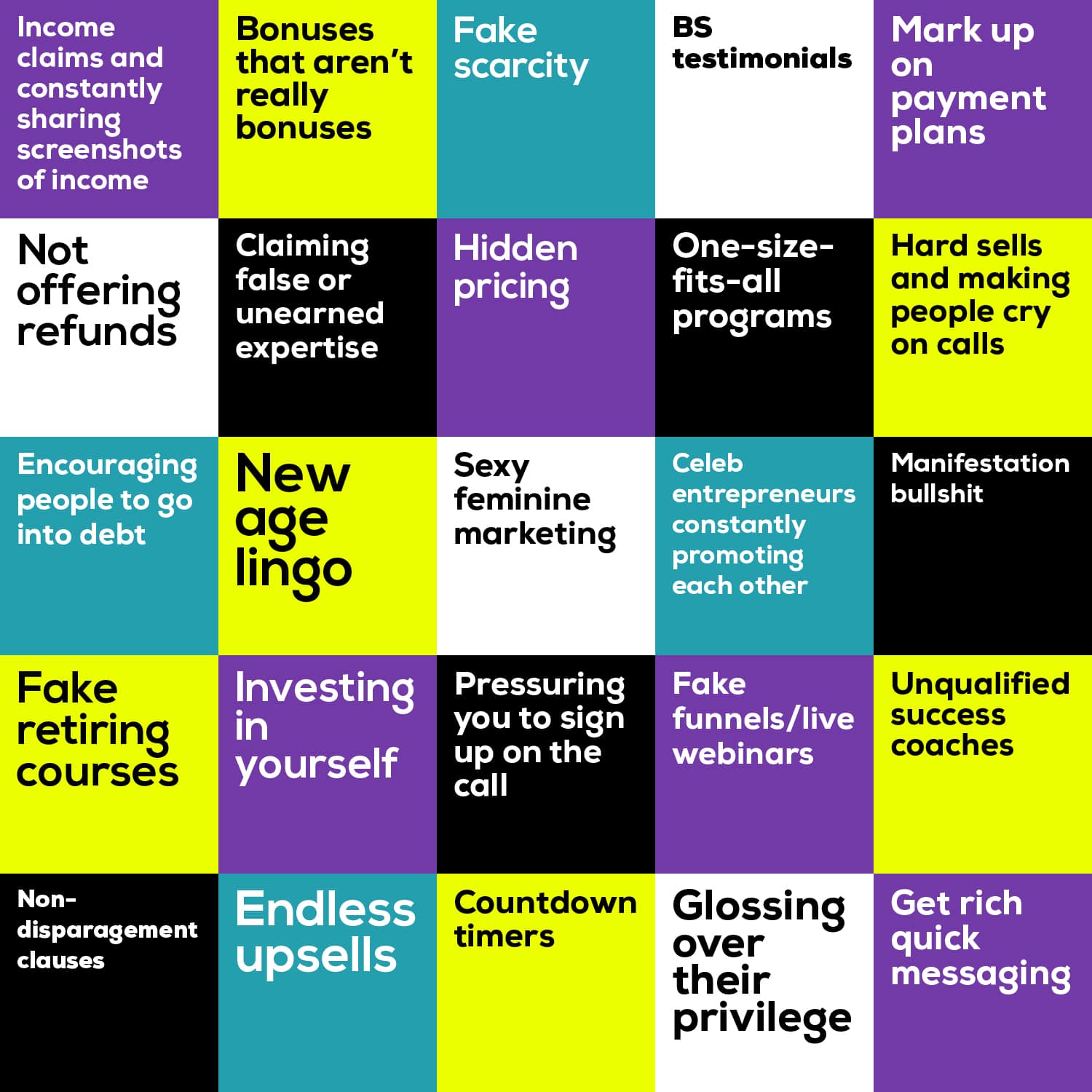
5 Lessons For Your Online Business
As I worked on reviewing all of the data and details for this essay, I spent a lot of time thinking about what this all meant. It’s not enough to serve up the data and my analysis; we need to learn from this to be better consumers and business owners.
Here are the lessons you can apply to your online business:
#1. Beware the Dream
At the heart of this industry is a dream of freedom and making millions that are being sold every single day. In reviewing survey responses, it was clear that this easy-peasy, make-all-the-money version of entrepreneurship is chewing people and spitting them out.
The truth? The dream is not as it appears, and when you invest your time and money with the wrong person, it can quickly turn into a nightmare. We need to look beyond the luxury lifestyle, income claims, and testimonials and see it for the fabricated BS it truly is.
As the saying goes, “if something seems too good to be true, it probably is.” That applies nowhere more than in the online business world. Look past the hype, and if you need support, find people who aren’t overpromising what they can help you achieve.
#2. Budget and Plan
One of the most fascinating yet frustrating parts of this survey was the section on spending habits. I wasn’t sure what to expect, especially as market conditions have evolved significantly since 2021. As much as I see more and more people becoming aware of the scammy tactics in the online business world, new grifts with totally new tactics are popping up daily.
One of the most powerful things you can do in your business to protect yourself is to budget and plan for your investments. With a clear plan for what support and training you may need in a given year, you’re less likely to fall into the trap of making an impulse purchase.
Take the time to map out what skills you need to build on or improve, where you need support, and so on. From there, establish a budget for how much you can invest in programs, courses, coaches, and masterminds.
Then, when you’re tempted to buy something, you can slow down, look at your plan and budget and make an informed decision. Slowing down often is enough to engage our sober second thought.
#3. Rigorously Vet Your Investments
Speaking of slowing down, I recommend that you create a checklist of things to review before you make any investments. If you’re looking for a place to start, the list of red flags included above, as well as the list of how people are vetting investments, can be two jumping-off points.
Consider what your deal breakers are when it comes to the red flags. For example, I don’t do business with people who don’t put prices on their sales pages. Your deal breakers may differ, but if you establish them in advance, you’ll be in a better place to assess investments with a clear head.
Another aspect of this is to go beyond testimonials, as those are only a snapshot of successes. If you can, talk to people you trust who may have been in that program. Many people cannot speak publicly about their experiences, but they’ll tell you the whole truth in a one-on-one setting.
Also, I recommend a very robust Google and Reddit search on that person’s name to see if there is any negative chatter about them. You may be surprised by what you discover about them that you would not know about otherwise.
#4. More Is Not Better
With all three of the investments included in the survey —best, worst and most expensive — the price points varied from under $250 to over $10,000. What was interesting is that, as consumers, we’re conditioned to think that paying more for something means it will be better quality or an elevated experience.
While that may be true with luxury travel or clothing, it’s usually untrue in online business. When you look at many of the five-figure plus investments, they often lack substance or real support. Instead of getting a small intimate group with support from the person selling you the offer, you end up with 50 or 100 other people and only get support from success coaches.
In looking at the investments in the $10k and over the mark in the survey results, those individuals were not any more successful with their investments, but they were more likely to feel like they had been burned.
So when making your investments, remember, more is not better. From a higher price tag to more content to more bonuses, it may simply be a sign that the offer is a cash grab, and these things are designed to make it feel like it’s worth it.
#5. Learn the Tactics
As I shared earlier in this essay, I firmly believe that the fastest way to see tangible change in this industry is for consumers to stop taking the bait. That’s not designed to blame or shame consumers but to take control and stop giving our time, money, and energy to people engaging in these business practices.
As long as the money keeps flowing in, these people are unlikely to change as what they’re doing is working for them and, in many cases, paying them extraordinarily well. But if we cut off their supply of people willing to pay, they’ll be forced to change.
Perhaps that seems overly idealistic, but I’m unwilling to sit on the sidelines and wait for regulations to catch up or for someone else to do something. We all can do something right now, and that starts with spending our money with people who will treat us well and making decisions to build our businesses free of these business practices.
Each one of us has the power and the agency to make more informed decisions and to realize that success doesn’t have to come in this 7-figure luxury life package we’re being sold.
The Wrap-Up
We made it. I hope you took away something actionable from these survey results and my analysis. This project was many months in the making, so again, a big thank you to everyone who supported it and shared their experiences with me.
Consumers
Want to explore more about tactics being used in online business?
Check out Duped: The Dark Side of Online Business.
Business Owners
Ready to get the BS out of your business?
Get more content like this on the BS-Free Service Business show.
